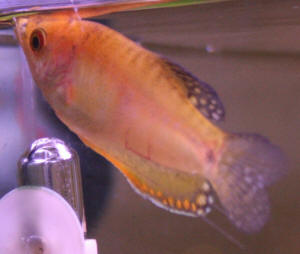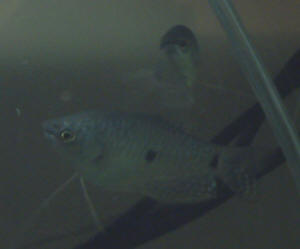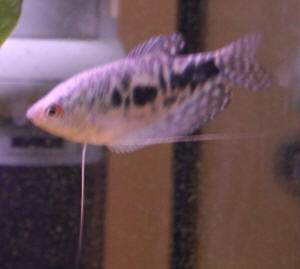|
FAQs on
the Blue, Three-Spot, Gold/en,
Opaline, Even Albino! Gouramis, Yes, The Same Species,
Trichogaster trichopterus, Identification
Related Articles: Anabantoids/Gouramis & Relatives,
Genera Ctenopoma &
Microctenopoma, Betta splendens/Siamese
Fighting Fish,
Related FAQs: &
FAQs on: Trichogaster trichopterus
1, Trichogaster trichopterus 2,
T. trichopterus Behavior, T. trichopterus Compatibility, T. trichopterus Selection, T. trichopterus Systems, T. trichopterus Feeding, T. trichopterus Disease, T. trichopterus Reproduction,
Gouramis 1, Gouramis 2, Gourami Identification, Gourami Behavior, Gourami Compatibility, Gourami Selection, Gourami Systems, Gourami Feeding, Gourami Disease, Gourami Reproduction, Betta splendens/Siamese Fighting
Fish,
|

|
|
forgot to add the pictures!!! Gourami ID, comp.
9/10/09
I recently purchased 4 of these guys (girls??) from my LFS, they
were sold to me as "TwinSpot Gourami" however, a search
in google has shown me there does not seem to be a "TwinSpot
Gourami". Can you identify this species for me, I have them
in my 55 gallon tank with my 12 shoaling neon tetras, and since
the tetras are so small I want to make sure they wont be eaten by
this new fish.
<Hello Colin. This is a blue morph Trichogaster trichopterus,
the fish scientists call the Three-spot Gourami (one spot is the
eye, another in the middle, and a third by the tail). It's a
hardy species, but the males are very aggressive towards each
other and sometimes towards other fish that look similar to them.
In a 55 gallon tank you should be fine though, especially if you
keep just one male. He has a longer dorsal fin than the female.
Cheers, Neale.>
|
 |
|
Gourami identification 12/22/08 Hi crew, I
currently have two gouramis in my 60 liter tank. I first bought
the yellow one (Gourami 2.jpg) sold as "gold Gourami"
with another gold Gourami. The second gold Gourami became very
aggressive (it was a male) and I returned it to the shop in
exchange for the blue Gourami (Gourami 1.jpg). Interestingly,
after I removed the aggressive gold Gourami, the remaining gold
one turned from pale yellow/white into the colour pattern as
shown on the picture. I believe I have two females now and the
blue Gourami is a "Trichogaster trichopterus -
Opaline". Can you help me identifying what type my gold
Gourami is? I was led to believe that two females can peacefully
live together, but the blue Gourami has become very aggressive to
the gold Gourami as well. Is that normal behaviour or should I
remove the aggressor? Thanks, Michiel <These are both
Trichogaster trichopterus, a species available in multiple
natural and artificial colour/pattern varieties. Colours may, in
some cases, be enhanced by fish farmers through the use of
various food supplements. Carotene and algae-rich foods will do
the trick under aquarium conditions, for example brine shrimp and
Spirulina flake. There's no real need to use "colour
enhancing" flake food if the diet is varied, and the effects
are likely to be minimal anyway. In any case, females have
smaller dorsal fins than males, so sexing is generally easy. On
males, the dorsal fin extends as far back as the caudal peduncle
(the "root" of the tail fin) whereas on the females the
dorsal fin is much smaller and has a rounded edge. Both your
specimens appear to be females, the blue one certainly so.
Trichogaster trichopterus is an aggressive species, and not a
species I personally consider a good community tank resident.
This species often becomes a bully, especially in small tanks. 60
litres (15 US gallons) is FAR TOO SMALL for this species, and
yes, they are going to fight. I'd recommend a tank of at
least 115 l (30 US gallons) for Trichogaster trichopterus.
Cheers, Neale.>
|
  |
Trichogaster trichopterus Hi,
<Hello, Sabrina here> I was unable to find any good documentation
about my Gourami. I have 2 female three spotted Gourami and they have
been living together for about 6 months. <Trichogaster trichopterus
is the Latin name - a Google search will yield great results, and
here's the WWM article: http://www.wetwebmedia.com/FWSubWebIndex/anabantoids.htm
.> Living with them, I have a small school of tiger barbs. The other
day I bought a pink kissing Gourami. Now one of my three spotted
Gourami has turned very dark and his spots have faded out so that it
appears as if it has no spots. I suspect that it may be stress because
the color change occurred within about 3 hours. A bacteria wouldn't
act this fast without harming any of the other fish right? <It's
certainly possible, but you're right on about stress, too. Now
you've just got to determine why the fish is stressed - illness,
perhaps; or maybe being bullied by that new kisser.> Anyway, that
fish now hangs out in the plants. How should I go about diagnosing what
is wrong? <A good starting point: http://www.wetwebmedia.com/FWSubWebIndex/fwfshparasites.htm
Other than that, observe the fish very closely, and separate to a
quarantine tank if at all possible, for better observation and to
protect the fish, also to prevent any possibility of spreading any
illness to other fish.> Thanks, Keeter <Wishing you well,
-Sabrina>
Gouramis weird behavior 8/5/07
My wife came home last week with a surprise birthday present... a 5-gal
tank setup, with everything the (supposedly knowledgeable) pet store
ppl said she would need, plus 2 Gouramis, which after looking at a lot
of online pictures seem like they're blue Gouramis, although they
look silver to me. She doesn't know the first thing about
fishkeeping, but she knows I am into fish so she spent the 80 bucks on
this whole thing, which is an Eclipse hex5 complete aquarium kit, plus
gravel, a heater, and a couple of plastic plants. Fine. So I set
everything up as carefully as I could, added warm water and
conditioner, started the filter going, the temp was in the high 70s,
floated the fish in the bag and added them after 45-50 minutes. Temp
stays between 77-80 even though heater is only set to 73. Basically,
since then they've been exhibiting really weird behavior. First of
all, one of them has from the beginning been chasing and nipping at the
other one. They alternate between floating at the top, hiding behind
the filter intake - or at the bottom behind a plant. When they're
not fighting they're usually separate, one in each of the
aforementioned locations. They picked-on one looks like its dorsal and
tailfins are starting to get ripped. I still have one day left on the
return policy. Is the best thing to just let them be; return one (and
hope to get some other kind of compatible fish); or return both and
start with some other fish? Thanks so much. -Moshe <Hello Moshe,
Although the fish you have may well be blue Gouramis -- Trichogaster
trichopterus -- this name "blue Gourami" is merely applied to
one variety within the species. The natural forms are silvery,
brownish, or light blue; the artificial varieties come in bright
yellow, lavender, and dark blue. The give-away clue for most varieties
is that there are three dark spots on each flank: one spot is the eye,
the second is halfway along the body, and the third close to the tail.
Right, now, having solved the identity of the fish: heating. Ignore the
number of the heater-thermostat. These devices are very simple
bi-metallic strips used to cut off the power above a certain
temperature. I remember learning about how these worked at school in
physics class, and I'm sure you do to. All that happens is above a
certain temperature one of the metals in the strip expands further than
the other, bending it away from the contacts, breaking the circuit.
These devices are very inaccurate. So, if your heater is heating the
tank too much, trust the thermometer, and set the heater lower. In
summer, I turn my heaters to their minimum settings: the day/night
cycle between around 25-18C / 77-64F is absolutely fine for most
tropical fish and far closer to the "wild" than the constant
temperatures we usually aim for. Second, the fighting: what you
describe is 100% normal for Trichogaster trichopterus. Males of this
species are mutually antagonistic, and males also tend to be bullies
towards any other Gouramis or even Gourami-looking fishes such as small
cichlids or Bettas. Males can be identified by their orange (rather
than white) pelvic fins (the "feelers") and their dorsal fins
(which are longer than those on the females). Thirdly, fin damage
should be treated *on sight* with anti-Finrot/fungus medication
pre-emptively. Failing to do this often leads to Finrot and fungus, and
once you start having sick fish, the hobby becomes a lot less fun.
Finally, you have a 5 gallon tank. I assume 5 US gallons, but 5
Imperial gallons would make any difference to this comment either: Your
tank is FAR TOO SMALL for anything much, let alone a pair of Gouramis.
With respect to your wife who doubtless was trying to buy you a nice,
fun present -- there's nothing more difficult in this hobby than
trying to make a stable aquarium in 5 gallons. It's too small.
Conditions easily slip from safe to dangerous, and very, very few fish
are inactive and small enough to be content in such tiny living
quarters. Thing about it, 5 gallons is the size of a bucket. Can you
imagine many fishes living in such a small "pond" in the
wild? At best, you could keep a few gobies and shrimps. Gobies are
small (most around an inch) and don't stray far from their chosen
cave (like a seashell). Bumblebee gobies (Brachygobius spp.) are the
most popular gobies in the hobby, though they will not eat flake and so
come under the heading of "fish for semi-experienced
hobbyists" in all fairness. On the shrimp front, there are these
darling little cherry shrimps (Neocaridina denticulata sinensis) that
are bright red and very easy to breed, and kept on their own with a few
aquarium plants can make enchanting pets. But other small things like
guppies or Neons won't be happy in a 5 gallon tank, whatever your
pet store tells you. Now, if you ask me why do pet shops sell tanks for
$80 that can't be used to keep fish, the answer is simple -- people
buy them as impulse presents or without knowing anything else about the
hobby. But 99 times out of a 100, these 5 gallon tanks end up sinking
into a morass of dead fish and bad water, and the would-be hobbyist
gives up. So, anyway, I hope this helps. Cheers, Neale>
|
|

